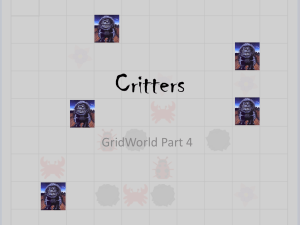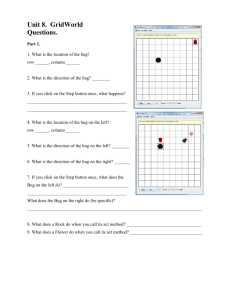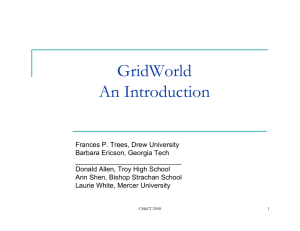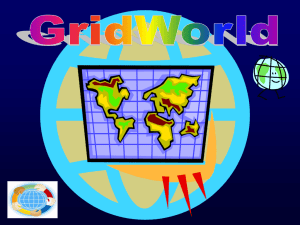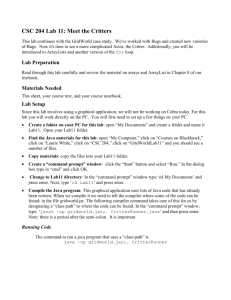A. Critter Methods
advertisement
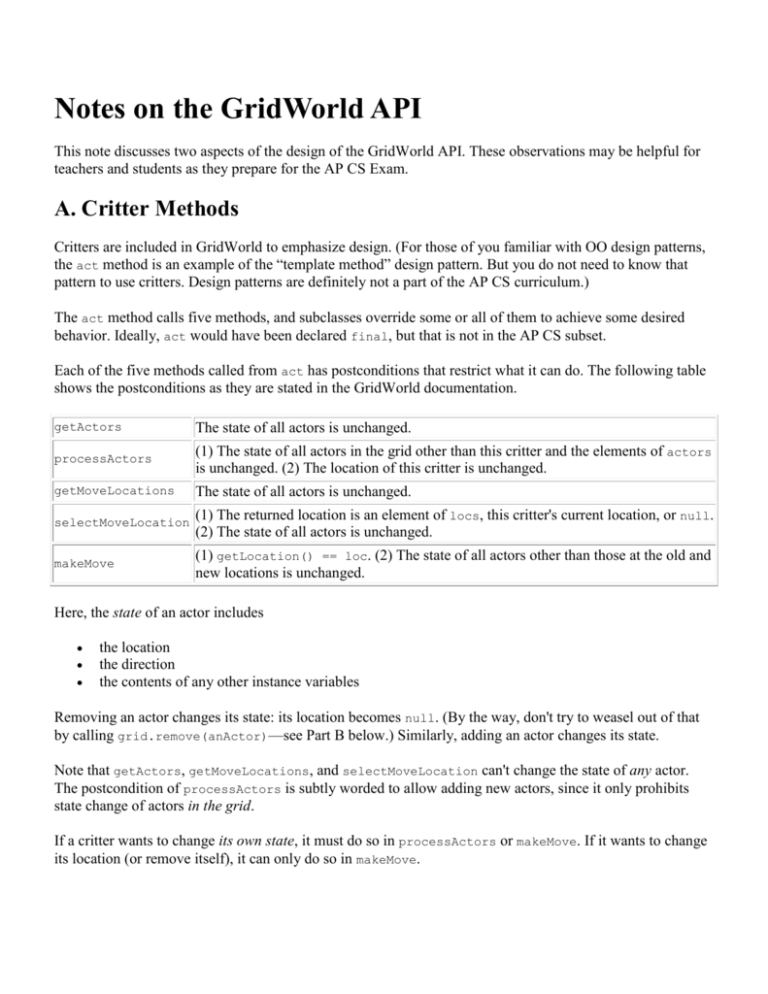
Notes on the GridWorld API This note discusses two aspects of the design of the GridWorld API. These observations may be helpful for teachers and students as they prepare for the AP CS Exam. A. Critter Methods Critters are included in GridWorld to emphasize design. (For those of you familiar with OO design patterns, the act method is an example of the “template method” design pattern. But you do not need to know that pattern to use critters. Design patterns are definitely not a part of the AP CS curriculum.) The act method calls five methods, and subclasses override some or all of them to achieve some desired behavior. Ideally, act would have been declared final, but that is not in the AP CS subset. Each of the five methods called from act has postconditions that restrict what it can do. The following table shows the postconditions as they are stated in the GridWorld documentation. getActors The state of all actors is unchanged. processActors (1) The state of all actors in the grid other than this critter and the elements of actors is unchanged. (2) The location of this critter is unchanged. getMoveLocations The state of all actors is unchanged. selectMoveLocation (1) The returned location is an element of locs, this critter's current location, or null. (2) The state of all actors is unchanged. makeMove (1) getLocation() == loc. (2) The state of all actors other than those at the old and new locations is unchanged. Here, the state of an actor includes the location the direction the contents of any other instance variables Removing an actor changes its state: its location becomes null. (By the way, don't try to weasel out of that by calling grid.remove(anActor)—see Part B below.) Similarly, adding an actor changes its state. Note that getActors, getMoveLocations, and selectMoveLocation can't change the state of any actor. The postcondition of processActors is subtly worded to allow adding new actors, since it only prohibits state change of actors in the grid. If a critter wants to change its own state, it must do so in processActors or makeMove. If it wants to change its location (or remove itself), it can only do so in makeMove. If a critter wants to change the state of another actor, it can only do so in processActors, and the actor must have been included in the actors parameter, or it must be newly added to the grid. (There is a teensy exception: makeMove removes the actor at the target location, and it may add a single actor, but only to the old location.) Finally, selectMoveLocations can only select from the locations that were handed to it. The makeMove method has even less choice—it must move to the location given in the parameter. These conditions significantly restrict what a critter can do, and how it can do it. For example, consider a BluesCritter that chooses a blue rock in the grid, eats the chosen rock's neighbors, and jumps to the rock (thereby removing it from the grid). The first method called by act is the getActors method. We must implement that method to return a set that includes the blue rock's neighbors since processActors can only remove actors that are given to it. But getActors cannot update any instance variable of the BluesCritter. In particular, it cannot store the blue rock's location. Instead, the processActors method must leave some trace of that location so that the getMoveLocations method can recall it. To finesse this, we can make the getActors method return all actors in the grid, so that processActors can pick a blue rock, remember its location, and remove its neighbors. When you design a particular critter, you need to distribute responsibilities among the five methods that are called by act. For example, in the BluesCritter class, if processActors sets an instance variable to the location of the chosen blue rock, the getMoveLocations relies on that setting. Some people are concerned about the apparent fragility of such an arrangement. What would happen if someone else called one of the methods, or if a subclass of BluesCritter changed one but not the other? In the context of the AP CS Exam, students should not worry about such issues unless they are specifically directed otherwise. These five methods were intended to be used in the act method, and not for any other purpose. To summarize, here are simple rules for your students when working with critters. Don't override act A critter can change its state only in processActors or makeMove A critter can change the state of other actors in processActors Remember, these rules are only for critters, not for bugs or other actors. Also keep in mind that not every actor can or should be represented as a critter. In the context of GridWorld, a critter is not a warm and fuzzy creature, but an actor that first processes actors and then makes a move. The BluesCritter doesn't fit that description very well, and it would have been better to design it as a BluesActor. Then you can override act without any tortured logic, simply moving to a blue rock and removing its neighbors. B. The Grid In a grid of actors, you must always use the putSelfInGrid/removeSelfFromGrid in the Actor class, and never the put/remove method of the Grid class. These methods ensure that the Grid reference in each Actor object properly refers to the grid containing the actor. In particular, don't try calling getGrid().remove(this) in an attempt to bypass the postcondition of a Critter method. The mere fact that the resulting code may happen to “work” when you run it in the GridWorld environment does not make it right. Of course, if you have a grid of other objects that are not actors, then use put and remove. Finally, it is easy to be confused about valid and empty locations. There are two simple rules. null is never a location. Do not pass it to any of the Grid methods, not even isValid. All methods other than isValid require a valid location. What happens if you pass null or an invalid location to a grid method? If you know that the grid is a a BoundedGrid or UnboundedGrid, then you can consult the implementation and see that a NullPointerException or IllegalArgumentException is thrown. But for a general Grid, you have no way of knowing what happens—someone could have implemented the Grid interface in a different way.
